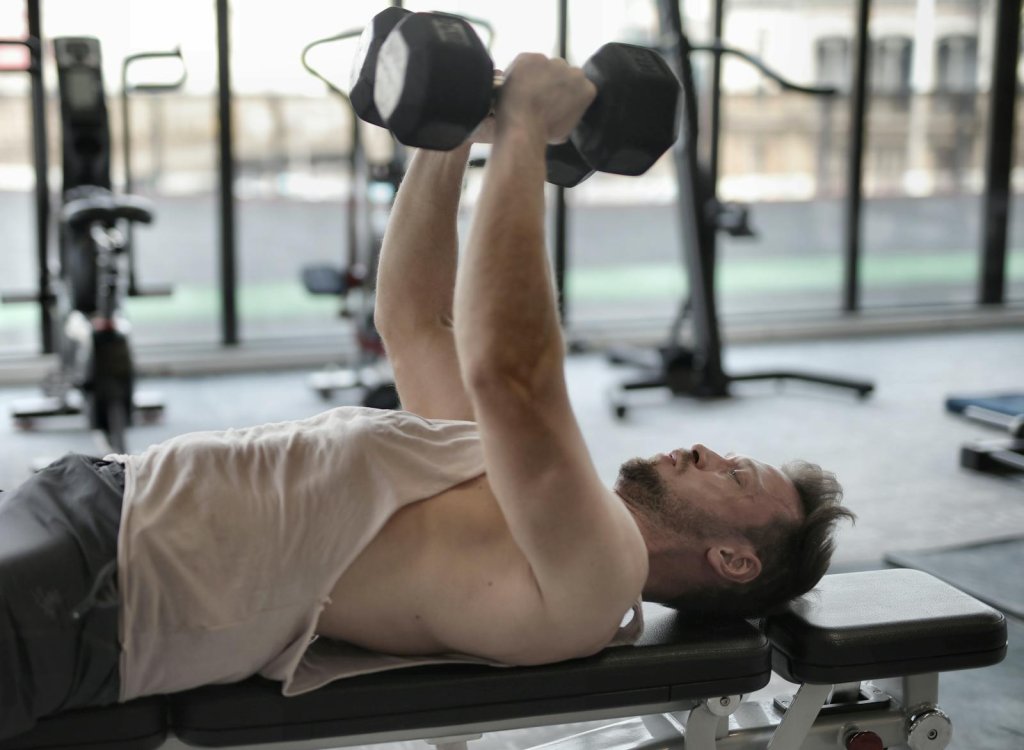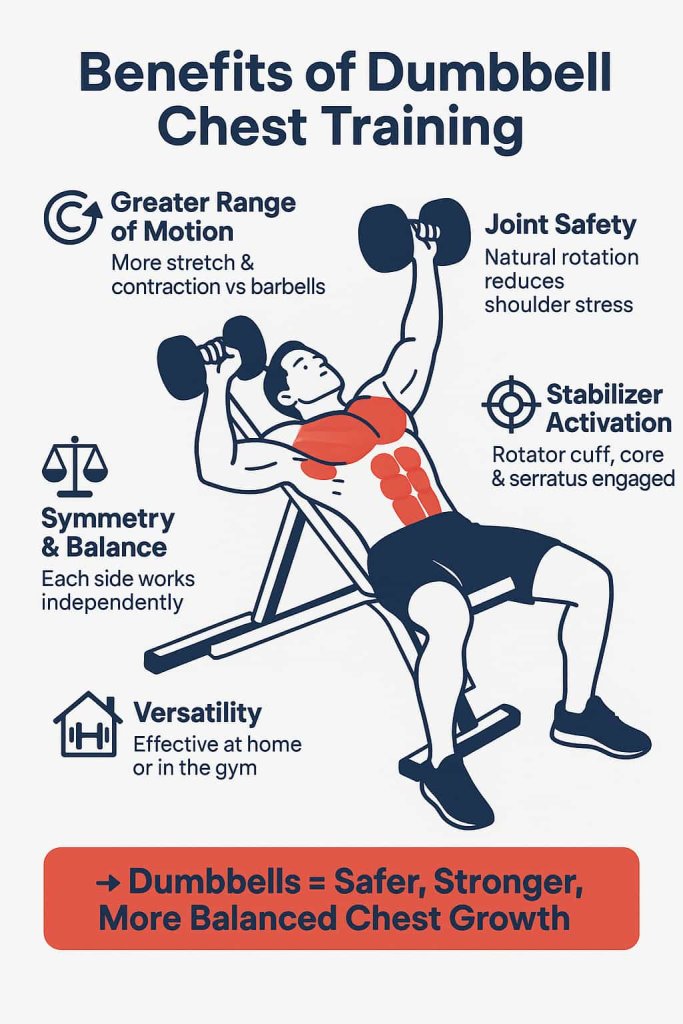Yes, dumbbell chest exercises are one of the most effective ways to build a bigger and stronger chest. Unlike barbells or machines, dumbbells allow a greater range of motion, correct muscle imbalances, and activate stabilizers for balanced growth.

If you want a fuller chest, you need a mix of pressing and fly movements across flat, incline, and decline angles. In this guide, we’ll cover 16 of the best dumbbell chest exercises, how to do them safely, the muscles they target, and pro tips to maximize results.
👉 According to StrengthLog (2024), dumbbells promote better chest activation by allowing natural arm movement and reducing shoulder strain compared to barbells.
Benefits of Dumbbell Chest Training

- Greater Range of Motion – More stretch and contraction than barbells.
- Symmetry & Balance – Each side works independently.
- Joint Safety – Natural hand rotation reduces shoulder stress.
- Stabilizer Activation – Engages rotator cuff, core, and serratus.
- Versatility – Can be done at home or in the gym.
Muscles Worked in Dumbbell Chest Exercises
- Pectoralis Major (sternal and clavicular heads) – main chest builder.
- Pectoralis Minor – supports scapula movement.
- Anterior Deltoids – assist in pressing.
- Triceps Brachii – lockout strength.
- Serratus Anterior & Core – stabilization during pressing.
16 Best Dumbbell Chest Exercises
1. Flat Dumbbell Bench Press
Why it works: Classic mass builder that hits the entire chest, especially the mid-pecs.
Muscles worked: Pectoralis major (sternal fibers), anterior deltoids, triceps.
How to do it:
- Lie on a flat bench, feet flat on the floor.
- Hold dumbbells at chest level with palms facing forward.
- Press dumbbells upward until arms are extended.
- Lower slowly to the starting position.
Trainer Tip: Keep elbows at a 45° angle to your torso—this protects shoulders and maximizes pec activation.
2. Incline Dumbbell Bench Press (15–30°)
Why it works: Puts maximum load on the upper chest.
Muscles worked: Clavicular head of pectoralis major, anterior deltoids, triceps.
How to do it:
- Set bench to a 15–30° incline.
- Hold dumbbells at chest height, palms forward.
- Press up until arms lock, then lower slowly.
Trainer Tip: Don’t set incline above 30° or the focus shifts to shoulders.
3. Decline Dumbbell Bench Press
Why it works: Targets lower chest fibers.
Muscles worked: Lower pectoralis major, triceps, front delts.
How to do it:
- Lie on a decline bench with dumbbells at chest.
- Press straight up and lower slowly.
Trainer Tip: Control the weights—decline position makes stability harder.
4. Dumbbell Floor Press
Why it works: Safer pressing with limited range; great for shoulders.
Muscles worked: Mid-to-lower chest, triceps.
How to do it:
- Lie flat on floor with dumbbells over chest.
- Lower elbows until they touch the ground.
- Press upward until arms lock.
Trainer Tip: Great choice if you want to lift heavy without stressing shoulders.
5. Flat Dumbbell Fly
Why it works: Stretches and isolates chest fibers.
Muscles worked: Pectoralis major, anterior delts.
How to do it:
- Lie on flat bench, dumbbells above chest with palms facing in.
- Lower arms out to sides with a slight elbow bend.
- Bring back together over chest.
Trainer Tip: Don’t overstretch—keep tension on chest, not shoulder joints.
6. Incline Dumbbell Fly
Why it works: Defines upper chest while isolating pecs.
Muscles worked: Upper pecs, front delts.
How to do it:
- Set bench to 15–30°.
- Lower dumbbells in wide arc, then squeeze chest to bring them back.
Trainer Tip: Move slowly—avoid jerking at the bottom of the stretch.
7. Decline Dumbbell Fly
Why it works: Shapes and isolates lower pecs.
Muscles worked: Lower pecs, front delts.
How to do it:
- Lie on decline bench, dumbbells above chest.
- Lower in wide arc, then bring together.
Trainer Tip: Use moderate weight—decline angle increases risk of overstretching.
8. Dumbbell Pullover
Why it works: Expands rib cage, stretches chest, also hits lats.
Muscles worked: Chest, lats, serratus anterior.
How to do it:
- Lie flat with dumbbell above chest.
- Lower weight behind head in arc.
- Pull back over chest with chest squeeze.
Trainer Tip: Keep hips low and core braced.
9. Close-Grip Dumbbell Press
Why it works: Focuses on inner chest and triceps.
Muscles worked: Inner pecs, triceps, front delts.
How to do it:
- Hold dumbbells close together above chest.
- Lower slowly, keeping them close.
- Press back up with chest squeeze.
Trainer Tip: Great for adding inner-pec detail.
10. Squeeze Press (Dumbbells Together)
Why it works: Creates constant chest tension.
Muscles worked: Inner pecs, triceps.
How to do it:
- Press dumbbells together throughout entire movement.
- Lower to chest and push back up.
Trainer Tip: Focus on squeezing pecs, not just pressing.
11. Neutral-Grip Dumbbell Press
Why it works: Shoulder-friendly alternative.
Muscles worked: Chest, triceps, anterior delts.
How to do it:
- Hold dumbbells with palms facing each other.
- Press upward in neutral grip.
Trainer Tip: Perfect for those with shoulder discomfort.
12. Single-Arm Dumbbell Press
Why it works: Unilateral pressing builds balance and core stability.
Muscles worked: Chest, triceps, obliques, core stabilizers.
How to do it:
- Press one dumbbell at a time while holding the other at chest.
- Alternate arms.
Trainer Tip: Keep torso square—don’t rotate.
13. Reverse-Grip Dumbbell Press
Why it works: Activates upper chest strongly.
Muscles worked: Upper pecs, triceps.
How to do it:
- Hold dumbbells with palms facing you.
- Press upward, keeping wrists stable.
Trainer Tip: Start light—reverse grip feels awkward at first.
14. Dumbbell Hex Press
Why it works: Combines press + squeeze for max inner chest tension.
Muscles worked: Chest, triceps.
How to do it:
- Hold dumbbells pressed together at chest.
- Press straight up and back.
Trainer Tip: Use lighter dumbbells to keep tension controlled.
15. Dumbbell Around the World
Why it works: Stretch-focused chest isolation.
Muscles worked: Pectoralis major, shoulders.
How to do it:
- Lie on bench, hold dumbbells at thighs.
- Move arms in wide arc overhead, then return.
Trainer Tip: Use very light weights—great stretch, but risky if heavy.
16. Dumbbell Push-Up with Rows (Renegade Style)
Why it works: Full-body move for chest, core, and back.
Muscles worked: Chest, triceps, lats, abs.
How to do it:
- Get into push-up position with dumbbells under hands.
- Perform push-up, then row one dumbbell to chest.
- Alternate rows.
Trainer Tip: Keep hips square—don’t let them twist during rows.
Programming Tips for Chest Growth
- Frequency: 2 times per week.
- Sets & Reps: 3–4 sets × 8–12 reps (hypertrophy).
- Progression: Increase weight or reps weekly.
- Mixing Angles: Use flat, incline, and decline for full chest development.
Common Mistakes to Avoid
- Flaring elbows too wide (shoulder strain).
- Bouncing dumbbells off chest.
- Using excessive weight and poor form.
- Not retracting scapula (weak activation).
- Cutting range of motion short.
Who Should Do Dumbbell Chest Exercises?
- Beginners: Great for learning pressing form.
- Intermediate/Advanced Lifters: For size, strength, and symmetry.
- Home Gym Athletes: Only need dumbbells and bench.
- Athletes: Functional carryover to pushing, sports power.
Safety Tips
- Warm up shoulders before pressing.
- Use spotter for heavy presses.
- Control descent, don’t drop dumbbells.
- Stick to safe angles if prone to shoulder pain (neutral grip, floor press).
FAQs
1. Can I build a big chest with dumbbells only?
Yes, dumbbells alone can build size and strength if you train progressively with proper volume.
2. Which dumbbell chest exercise is best for beginners?
The flat dumbbell bench press is safest and most effective to start with.
3. Should I do incline or flat dumbbell presses?
Do both—flat for overall mass, incline for upper chest balance.
4. Are flyes necessary for chest growth?
Flyes isolate the chest and improve stretch, making them excellent alongside presses.
5. How heavy should my dumbbells be?
Choose a weight that allows 8–12 controlled reps with good form.
6. How often should I train chest with dumbbells?
2 times per week is optimal for most lifters.
7. Are dumbbell chest exercises safer than barbell bench press?
Yes, they allow natural movement and reduce shoulder stress, but still require control.
Conclusion
Dumbbell chest training offers unmatched versatility and effectiveness. By combining presses, flyes, and accessory moves across multiple angles, you’ll maximize pec size, strength, and definition.
👉 Start with flat and incline presses + flyes, then add variations for full chest growth.
